Houses are made of stone – nothing new. But on Dingle, some houses are really COMPLETELY made of stone – and they’re stone old too…
Page Contents (click line to jump the text)
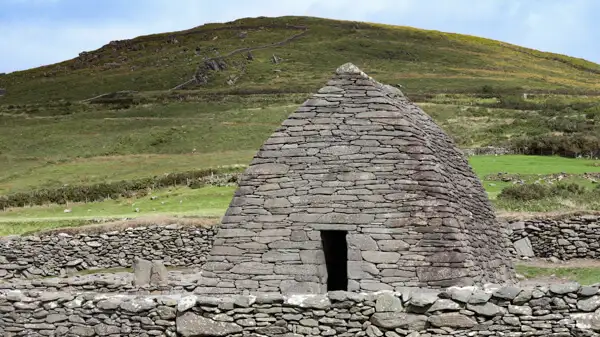
Intro
The Dingle Peninsula in County Kerry in the south-west of Ireland has long ceased to be an insider tip. It attracts many visitors every summer. But don’t worry, Dingle is not overcrowded.
Dingle really deserves this much affection. The island, or rather peninsula, is simply too beautiful!
You can simply drive along the coast and enjoy the beautiful views. The Slea Head Drive around the west coast is especially marvellous. Beautiful day – let’s move on…
But you can also stop occasionally and take in a few small sights. Each one is quickly seen on its own, but together they give you an interesting picture of this very special area.
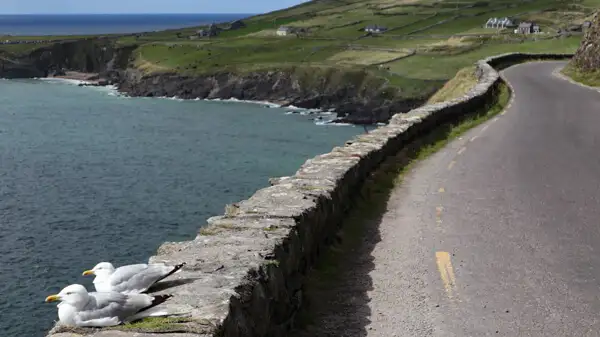
Take your time in the south-west, the area is too beautiful to just “drive around”. Incidentally, you can also spend the night on Dingle. I have visited Dingle several times, both by car and by motorbike. And I’d love to come back again.
We come from Germany, but have lived in Ireland for several years (second home) and have travelled the isle many times.
Why is Dingle so special? Among other things, it has to do with ancient cultures – but we’ll come to that in a moment…
Some background about the Dingle Peninsula
Several thousand years before Christ, and thus long before the Celts, people lived here on Dingle. They lived in simple huts, but they built with stones and rocks: dolmens, portal tombs, standing stones and walls piled up from rough stones, which were probably enclosures for livestock. Many of these stone remains of human civilisation can still be found on the peninsula today, especially on the western coast.
Much later, around the 4th or 5th century, people erected Ogham stones near Ballintagart. There is a stone ring and several upright stones with symbols and characters that originate from the early Irish Gaelic alphabet and are vaguely reminiscent of cuneiform scripts that were also used on the European continent.
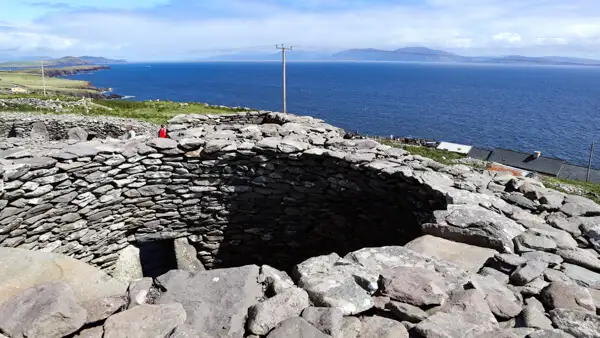
The hemispherical Beehive Huts were probably also built around this time, the early Christian period in Ireland. They are built entirely of rough stone, without the use of mortar. Similar beehive huts can also be found on Skellig Micheal. They were used by early Christian monks as modest accommodation.
The Gallarus Oratory is more likely to date from the 7th or 8th century and was also part of a monastery. This building is also built entirely of stone without mortar, but is much more finely and precisely crafted and has an elongated shape.
The small town of Dingle was an early harbour and served as a hub for international trade in butter, fish and animal skins from Ireland, as well as wine and other products from southern Europe. Spanish and French fleets were trading partners and used the harbour as a base.
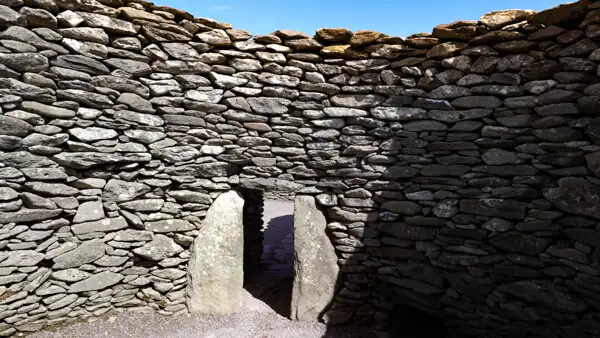
Later, fishing and linen production flourished and there were also various military activities. The small town of Dingle once exported more than Limerick, which is much larger today. In fact, about three times as many people lived there back then than today.
Today, the Dingle Peninsula is one of the most important tourist destinations on the south-west coast, together with its southern neighbour, the Iveragh Peninsula, whose coastal road is better known as the Ring of Kerry.
The Beehive Huts on Dingle Peninsula
Beehive huts are a speciality of the British Isles. They actually look a bit like a beehive, hence the name.
They were mainly built during the Iron Age and also in the early Christian period and probably originate from traditional Gaelic construction methods.
They can be found in various places in Ireland, but also in Scotland and Cornwall, as well as in various provinces of France and Spain, which were also populated by Celts, from whom the Gaelic tribes of the British Isles presumably emerged.
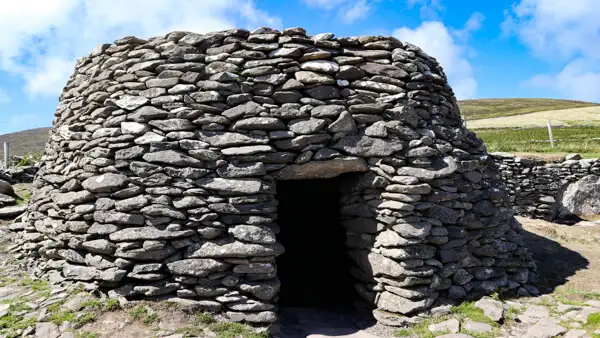
Many of these Beehive Huts were simple accommodation for early Christian monks, such as on Dingle and on the rocky island of Skellig Michael off the coast of Kerry.
If you’ve seen the Star Wars film “The Force Awakens”, then you’ll already be familiar with Beehive Huts, as the scenes with old Luke Skywalker on a rocky island were filmed on Skellig Michael.
On Dingle you will find beautiful Beehive Huts on the R559 Slea Head Drive on the south-west coast off Slea Head. See also: https://www.beehivehuts.com/.
From there you also have a wonderful view of the coast (see photos).
The Gallarus Oratory on Dingle
The Gallarus Oratory is not located directly on the coast, but between the small villages of Gallarus and Ballynana, in the western part of the island.
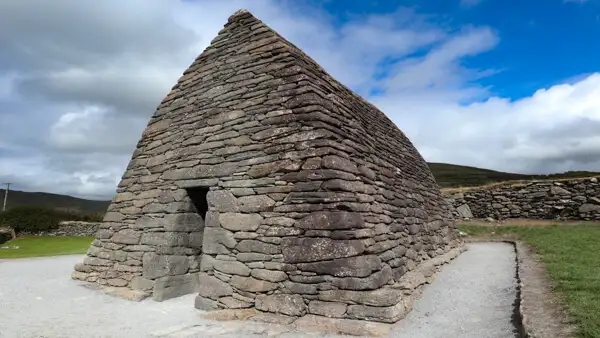
It is a church, or chapel, built sometime in the early Middle Ages, but some time after the Beehive Huts. The architectural style is much more sophisticated and the stonework much more precise than that of the Beehive Huts, some of which were built very primitively.
The Gallarus Oratory was part of a monastery. It has an elongated shape with a gable and is reminiscent of an inverted small nave. The building is made entirely of stone, with the walls and roof merging into one another.
The oratory is in excellent condition and is unique on the island. I really enjoyed my visit.
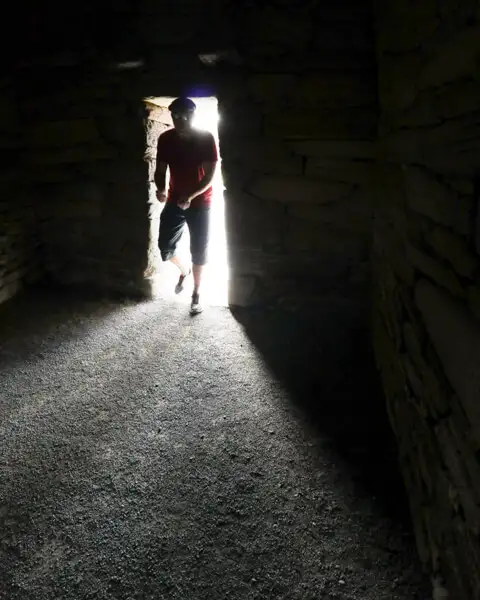
The Great Famine and abandoned Cottages
In the middle of the 19th century, over 8 million people lived on the island of Ireland. The potato was an extremely important staple food for the people. However, a fungus introduced from America destroyed the potatoes and entire harvests failed for several years as a result. This led to a great famine, the Great Famine, to which many people fell victim.
Around 1.5 million Irish emigrated to America, Canada, Australia and New Zealand to escape the hardship. In 1904, there were only around 4.4 million inhabitants on the island. Today, there are again around 5.1 million in Ireland and around 1.8 million in Northern Ireland, i.e. just under 7 million people on the island – still fewer than before the famine.
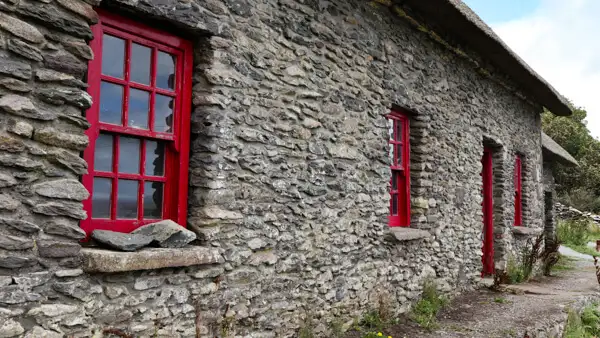
The cottages that the emigrants left behind remained empty. Entire settlements were abandoned. Today you can still find the remains of these abandoned famine cottages in many places on the island. This is also the case here on Dingle, where you can see some of them.
You can also find them on Slea Head Drive, not far from the Beehive Huts. See: https://dinglesheepdogs.com/cottage.
Of course, the whole thing is a bit touristy, but I still found the cottages very interesting.
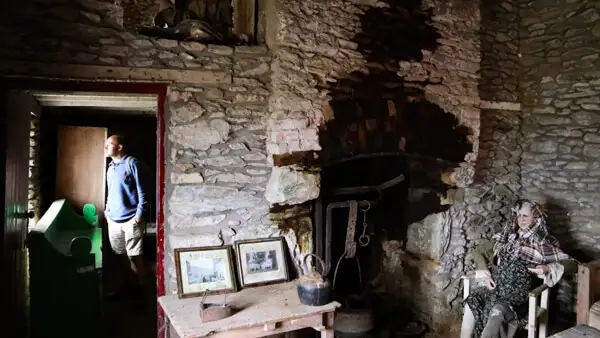
What else you can see in the area
Dingle Town
Dingle on the peninsula of the same name is a nice little harbour town. You can definitely take a break here and take a short walk through the town and harbour. There is also a small aquarium there, see: https://www.dingle-oceanworld.ie/. You can also go on a dolphin-watching tour by boat, and even go as far as the Blasket Islands: https://www.dingledolphin.com/.
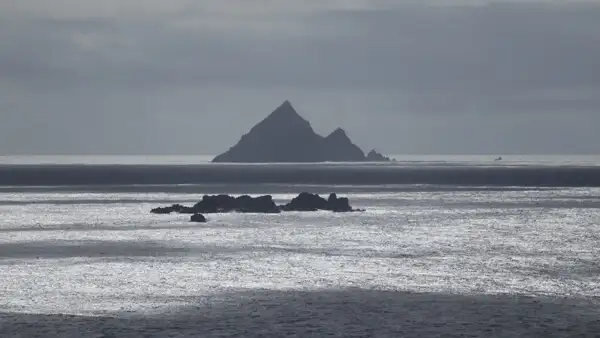
Castlegregory Beach
On the north coast of the Dingle Peninsula lies the village of Castlegregory, which has a very beautiful and very big sandy beach – just take a drive past and check it out!
Conor Pass
From Dingle, you can take the R560 over the Conor Pass towards Castlegregory and Tralee. At the top of the pass you have marvellous views of the north coast and the south coast at the same time. At 952 metres high, Mount Brandon is the highest mountain on Dingle and one of the highest mountains in Ireland. It was an important place in Irish mythology and later an important pilgrimage site, much like Croagh Patrick still is today.
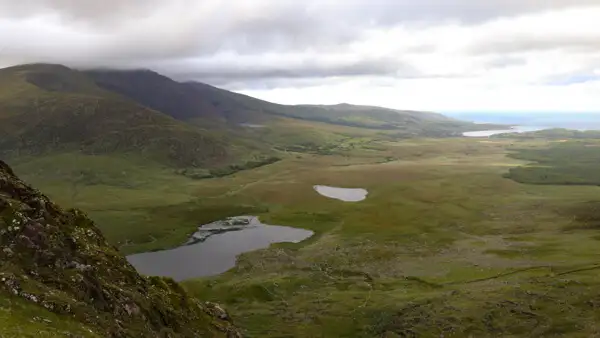
Cashel Murphy and the Celtic settlement
On Slea Head Drive, near the Beehive Huts, you will find a small car park. A very short walk up the hill will take you to Cashel Murphy and the remains of a Celtic settlement. A cashel is the forerunner of a castle, in this case the ruins of a small, round castle made of rough stones, in the centre of which there are other round building structures reminiscent of Beehive Huts.
Inch Beach
Inche Beach is a flat headland on the southern shore, close to the mainland. You can easily reach it via the R561. There is plenty of sandy beach, beautiful sand dunes and a surfer café. Surfers practise on the beach and you can hire a board. In the background you can see the mountains of Killarney National Park – a marvellous landscape!
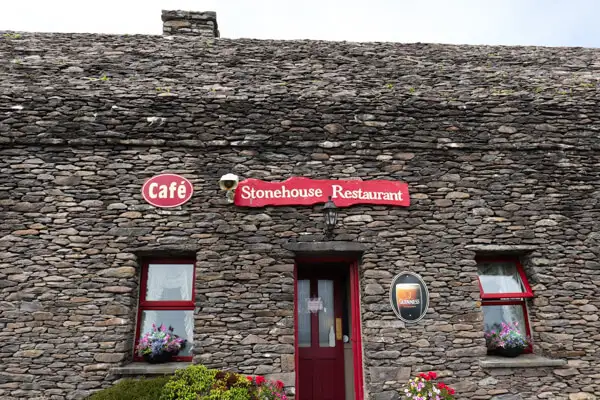
Conclusion
Dingle is a special place. Not an insider tip, but definitely a recommendation!
If you just want to enjoy the beautiful coastline of the peninsula, this is the place for you. If you’re interested in Irish culture and history, this is also the place for you.
And if you want to visit the Ring of Kerry and Killarney National Park, you’re close by.
I really enjoyed my visits to the Dingle Peninsula and will definitely go there again. I hope you feel the same way!
I wish you lots of fun on Dingle!
More interesting articles for you
THE FAMOUS CLIFFS OF MOHER
THE ROCKY BURREN – A VERY SPECIAL LANDSCAPE IN IRELAND
AUGHNANURE CASTLE IN CONNEMARA – A WELL HIDDEN GEM
DROMBEG STONE CIRCLE – THE MEGALITHIC HERITAGE OF IRELAND
Picture credits cover picture: Beehive huts and coastline of Dingle Peninsula, photo: Ulrich Knüppel-Gertberg ( www.irland-insider.de, www.ireland-insider.com)